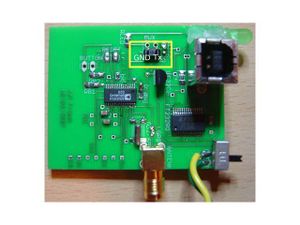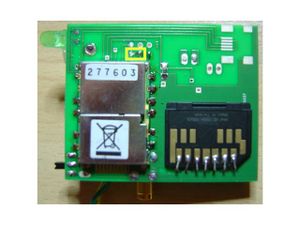Difference between revisions of "GPS"
From ArmadeusWiki
m |
m (→Usage) |
||
| Line 23: | Line 23: | ||
==Usage== | ==Usage== | ||
| − | * Configure Serial port 1 of your | + | === APF27 Wireless=== |
| + | * Configure Serial port 4 of your APF27 (38400 bauds 8N1): | ||
| + | <pre class="apf"> | ||
| + | # stty -F /dev/ttySMX4 38400 | ||
| + | </pre> | ||
| + | |||
| + | * Test it: you'll get NMEA frames: | ||
| + | <pre class="apf"> | ||
| + | # cat /dev/ttySMX4 | ||
| + | $GPGSV,3,1,12,01,80,354,,02,32,070,38,04,13,037,09,09,14,146,*78 | ||
| + | |||
| + | $GPRMC,164916.00,V,,,,,,,130709,,,N*7C | ||
| + | |||
| + | $GPGGA,164916.00,,,,,0,00,99.99,,,,,,*6B | ||
| + | </pre> | ||
| + | |||
| + | === APF9328 === | ||
| + | * Configure Serial port 1 of your APF9328 (4800 bauds 8N1): | ||
<pre class="apf"> | <pre class="apf"> | ||
# stty -F /dev/ttySMX1 4800 | # stty -F /dev/ttySMX1 4800 | ||
Revision as of 18:55, 13 July 2009
This page will summarize informations to connect GPS modules to your Armadeus board.
Contents
Introduction
GPS stands for Global Positioning System and is intended to allow one to knows its localization on Earth quite accuratly. See this Wikipedia article for more informations.
APF27Wireless hardware
The uBlox NEO-5M module is used on the APF27Wireless board. The specifications can be found here: http://www.ublox.com/en/gps-modules/pvt-modules/neo-5m.html
Other tested hardware
GPS receivers are generally driven through a low speed RS232 bus or USB.
RS232 modules
The following RS232 receivers were successfully tested:
- the GPS receiver of the Projet Aurore association. This autonomous receiver uses a standard NMEA GPS module that can be connected to the 3,3V RS232 port of your APF9328. All you need to do is to get the GND and TX signals out of this module and connect is to your GND and RX signals of your APF:
- the GPS receiver of the APF27 Wireless extension board
USB modules
These modules are mostly serial one with a RS232 <-> USB converter.
Usage
APF27 Wireless
- Configure Serial port 4 of your APF27 (38400 bauds 8N1):
# stty -F /dev/ttySMX4 38400
- Test it: you'll get NMEA frames:
# cat /dev/ttySMX4 $GPGSV,3,1,12,01,80,354,,02,32,070,38,04,13,037,09,09,14,146,*78 $GPRMC,164916.00,V,,,,,,,130709,,,N*7C $GPGGA,164916.00,,,,,0,00,99.99,,,,,,*6B
APF9328
- Configure Serial port 1 of your APF9328 (4800 bauds 8N1):
# stty -F /dev/ttySMX1 4800
- Power on your GPS module
- Test it: you'll get NMEA frames:
# cat /dev/ttySMX1 $GPGGA,000026.032,,,,,0,00,,,M,0.0,M,,0000*53 $GPGSA,A,1,,,,,,,,,,,,,,,*1E $GPRMC,000026.032,V,,,,,,,160406,,*2F $GPGGA,000027.032,,,,,0,00,,,M,0.0,M,,0000*52
There is a small tool (under development) in target/demos/gps/ that can help you to parse some NMEA frames.
NMEA Frames signification
- $GPGGA: Global Positioning System Fix Data
- $GPGLL: Geographic Position, Latitude/Longitude
- $GPGSA: GPS DOP and Active Satellites
- $GPGSV: GPS Satellites in View
- $GPRMB: Recommended Minimum Navigation Information
- $GPRMC: Recommended Minimum Specific GPS/TRANSIT Data
Troubleshots
- In case your Aurore GPS module is detected and then automatically removed from USB stack when you plug it on your PC, try to deinstall that:
$ sudo apt-get remove brltty

